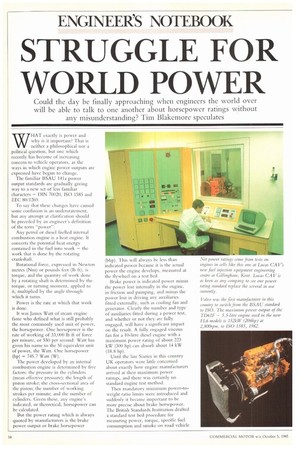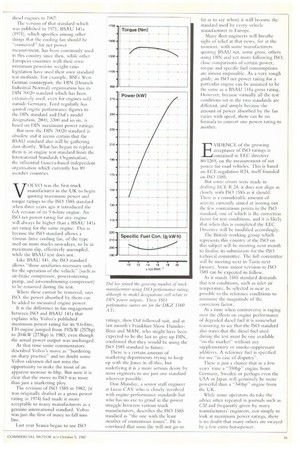ENGINEER'S NOWBOOK
Page 76

Page 77

If you've noticed an error in this article please click here to report it so we can fix it.
STRUGGLE FOR WORLD POWER
Could the day be finally approaching when engineers the world over will be able to talk to one another about horsepower ratings without any misunderstanding? Tim Blakemore speculates
WHAT exactly is power and why is it important? That is neither a philosophical nor a political question, but one which recently has become of increasing concern to vehicle operators, as the ways in which engine power outputs are expressed have begun to change.
The familiar BSAU 141a power output standards are gradually giving way to a new set of less familiar characters — DIN 70020, ISO 1585 and EEC 80/1269.
To say that these changes have caused some confusion is an understatement, but any attempt at clarification should be preceded by an engineer's definition of the term "power".
Any petrol or diesel fuelled internal combustion engine is a heat engine. It converts the potential heat energy contained in the fuel into work — the work that is done by the rotating crankshaft.
Rotational force, expressed in Newton metres (Nin) or pounds feet (lb ft), is torque, and the quantity of work done by a rotating shaft is determined by the torque, or turning moment, applied to it, multiplied by the angle through which it turns.
Power is the rate at which that work is done.
It was James Watt of steam engine fame who defined what is still probably the most commonly used unit of power, the horsepower. One horsepower is the rate of working of 33,000 lb ft of force per minute, or 550 per second. Watt has given his name to the SI equivalent unit of power, the Watt. One horsepower (hp) = 745.7 Watt (W).
The power developed by an internal combustion engine is determined by five factors: the pressure in the cylinders (mean effective pressure); the length of piston stroke; the cross-sectional area of the piston; the number of working strokes per minute; and the number of cylinders. Given these, any engine's indicated, or theoretical, horsepower can be calculated.
But the power rating which is always quoted by manufacturers is the brake power output or brake horsepower (bhp). This will always be less than indicated power because it is the actual power the engine develops, measured at the flywheel on a test bed.
Brake power is indicated power minus the power lost internally in the engine, in friction and pumping, and minus the power lost in driving any auxiliaries fitted externally, such as cooling fan and generator. Clearly the number and type of auxiliaries fitted during a power test, and whether or not they are fully engaged, will have a significant impact on the result. A fully engaged viscous fan for a 10-litre diesel engine with a maximum power rating of about 223 kW (300 hp) can absorb about 14 kW (18.8 hp).
Until the late Sixties in this country UK operators were little concerned about exactly how engine manufacturers arrived at their maximum power ratings, and there was certainly no standard engine test method.
Then mandatory minimum power-toweight ratio limits were introduced and suddenly it became important to be more precise about brake horsepower. The British Standards Institution drafted a standard test bed procedure for measuring power, torque, specific fuel consumption and smoke on road vehicle Net power ratings cotne from tests on engines in cells like this one at Lucas CA V's new fitel inject ion equipment engineering centre at Gillingham, Kent. Lucas CA V is as keen as any company to see one power rating standard replace the several in use currently.
Volvo was the.iirst manufacturer in this country to switch .from the BSAU standard to ISO. The maximum power output of the TD61F — 5.5-litre engine used in the new FL6 models is 152hIc (204hp) at
2,800rpm, to ISO 1585, 1982. diesel engines in 1967.
The version of that standard which was published in 1971, BSA U 141a (1971), which specifies among other things that the cooling fan should be "connected" for net power measurement, has been commonly used in this country since then, while other European countries with their own minimum power-to weight ratio legislation have used their own standard test methods. For example, BSI's West German counterpart, the DIN (Deutsch Industrial Normal) organisation has its DIN 70020 standard which has been extensively used, even for engines sold outside Germany. Ford regularly has quoted engine performance figures to the DIN standard and Dais model designation, 2800, 3300 and so on, is based on DIN maximum power ratings.
But now the DIN 70020 standard is obsolete and it seems certain that the BSAU standard also will be gathering dust shortly. What has begun to replace them is an engine test standard from the International Standards Organisation, the influential Geneva-based independent organisation which currently has 89 member countries.
VOLVO was the first truck manufacturer in the UK to begin quotilig maxinium power and torque ratings to the IS() 1585 standard when three years ago it introduced the GA version of its 9.6-litre engine. An ISO net power rating for any engine will always he higher than a BSAU 141a net rating for the same engine. This is because the ISO standard allows a viscous drive cooling fan, of the type used on most trucks nowadays, to be at maximum slip, effectively uncoupled, while the BSAU test does not.
Like BSAU 141, the ISO standard allows "those auxiliaries necessary only for the operation of the vehicle" (such as air-brake compressor, power-steering pump, and air-conditioning compressor) to be removed during the test.
Where these cannot be removed, says ISO, the power absorbed by them can be added to measured engine power.
It is the difference in fan engagement between ISO and BSAU 141a that explains why Volvo's published maximum power rating for its 9.6-litre, F10 engine jumped from 192kW (257hp) to 204kW (273hp) in 1983, even though the actual power output was unchanged.
At that time some commentators described Volvo's move as "bordering on sharp practice" and no doubt some Volvo salesmen did not miss the opportunity to make the most of an apparent increase in bhp. But now it is clear that the move to ISO was more than just a marketing ploy.
The revision of ISO 1585 in 1982, (it was originally drafted as a gross power rating in 1974) had made it more acceptable to many manufacturers as a genuine international standard. Volvo was just the first of many to fall into line.
Last year Scanta began to use ISO ratings, then Daf followed suit, and at last month's Frankfurt Show DaimlerBenz and MAN, who might have been expected to be the last to give up DIN, confirmed that they would be using the ISO 1585 standard in future.
There is a certain amount of marketing departments trying to keep up with the Jones in all this, but underlying it is a more serious desire by most engineers to use just one standard wherever possible.
Don Munday, a senior staff engineer at Lucas CAV who is closely involved with engine performance standards but who has no axe to grind in the power struggle between various truck manufacturers, describes the ISO 1585 standard as "the one with the least number of contentious issues". He is convinced that soon (he will not go so far as to say when) it will become the standard used by every vehicle manufacturer in Europe.
Many fleet engineers will breathe sighs of relief at that news, for at the moment, with some manufacturers quoting BSAU net, some gross, others using DIN and yet more following ISO, close comparisons of certain power, torque and specific fuel COLISLIMptions are almost impossible. As a very rough guide, an IS() net power rating for a particular engine can be assumed to be the same as a BSAU 141a gross rating. lowever, because virtually all the test conditions set in the two standards are different, and simply because the amount of power absorbed by the fan varies with speed, there can be no formula to convert one power rating to another.
F1 V1DENCE of the growing acceptance of ISO ratings is
4
contained in EEC directive 80/1269, on the measurement of net power for road vehicles. This is based on ECE regulation 1(24, itself founded on ISO 1585.
But some errors were made in drafting ECE It 24; it does not align as closely with IS() 1585 as it should. There is a considerable amount of activity currently aimed at ironing out the few contentious points in the ISO standard, one of which is the correction factor for test conditions, and it is likely that when this is completed the EEC Directisx will be modified accordingly.
The British working group which represents this country at the ISO on this subject will be meeting next month to finalise its submission for the ISO technical committee. The full committee will be meeting next in Turin next January. Some minor revision to ISO 1585 can be expected to follow.
As it stands 1585 standard demands that test conditions, such as inlet air temperature, be selected as near as possible to the reference conditions to minimise the magnitude of the correction factor.
At a time when controversy is raging over the effects on engine performance of degraded diesel fuel it is somewhat reassuring to see that the ISO standard also states that the diesel fuel used during the test must be one available "on the market" without any supplementary or smoke-suppressant additives. A reference fuel is specified for use "in case of disputes".
There is just a chance that in a few years' time a "350hp" engine from Germany, Sweden or perhaps even the USA or Japan will genuinely be more powerful than a "340hp" engine from the UK.
While sonic operators do take the advice often repeated in journals such as CM and frequently given by many manufacturers' engineers, not simply to look at maximum power ratings, there is no doubt that many others are swayed by a few extra horsepower.












































































































